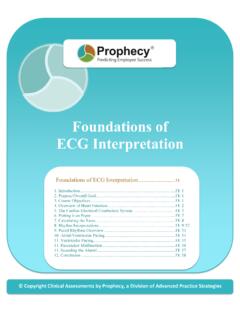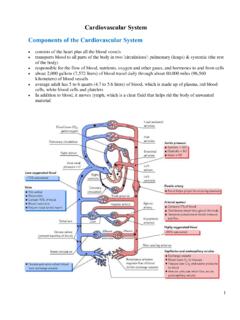Transcription of Six Second ECG eBook - SkillStat
1 5 SBDZ 1 BVM #BSJMM" 1 SBDUJDBM (VJEF UP #BTJD BOE -FBE5IF 4JY 4 FDPOE &$(&$( *OUFSQSFUBUJPOThe Six Second ECGA Practical Guide to Basic and 12 Lead ECG InterpretationCopyright 2012 by SkillStat Learning rights reserved. No part of this book may be reproduced in any form by any electronic or mechanical means including photocopying, recording, or information storage and retrieval without permission in writing from the : 978-0-9864723-0 The Six Second ECG Website : feedback on The Six Second ECG at: SkillStat Learning Vancouver, British Columbia, CanadaPalm Springs, California, USAA lthough every precaution has been taken in the preparation of this book, SkillStat Learning Inc. assumes no re-sponsibility for errors or omissions. No liability is assumed for damages resulting from the use of the information contained : Tracy BarillTable of Contents iContents At a GlanceTable of Contents.)))
2 IiiList of Figures .. viiiIntroduction .. 1 Chambers, Valves and Vessels .. 7It s All About Cardiac Output .. 21 The Electrics .. 45An ECG Primer .. 63In Four Simple Steps .. 101 The 12 Lead ECG .. 137 Glossary .. 189 Index .. 211ii The Six Second ECGT able of Contents iiiTable of ContentsList of Figures ..viiiIntroduction .. 1 This Book is For You .. 1 How to Use This Book .. 2 Brief Synopsis .. 3 The Author .. 4 Acknowledgements .. 4 Let s Get Started! .. 5 Chapter 1: Chambers, Valves and Vessels .. 7 Overview .. 8 The Mechanical Structures of the Heart .. 9 Layers .. 10 Chambers .. 11 Valves .. 12 Coronary Arteries .. 14 Major Vessels .. 15 Atrial Fibrillation and the Major Vessels .. 17 Summary .. 17 Chapter Quiz .. 18 Suggested Readings and Resources .. 20 What s Next? .. 20 Chapter 2: It s All About Cardiac Output.
3 21 The Cardiac Cycle .. 22 What is Cardiac Output? .. 24 Why is Cardiac Output Vital? .. 25 Blood, Oxygen and Aerobic Metabolism .. 25 Anaerobic Metabolism .. 26iv The Six Second ECGF lash Quiz .. 28 Parameters that Affect Cardiac Output .. 30 Heart Rate .. 30 Stroke Volume .. 32 Applying Concepts of Cardiac Output Regulation .. 36 Summary .. 40 Chapter Quiz .. 41 Suggested Readings and Resources .. 44 What s Next? .. 44 Chapter 3: The Electrics .. 45 Electrical Overview .. 46SA Node .. 47 Atrial Conduction and the AV Junction .. 49 The Ventricular Conduction system .. 50 Controlling Heart Rate .. 53 Summary .. 56 Chapter Quiz .. 57 Suggested Readings and Resources .. 61 What s Next? .. 62 Chapter 4: An ECG Primer .. 63 Cardiac Monitoring system .. 64 The 3 Lead Wire ECG system (Einthoven s Triangle) .. 64 The 5 Lead Wire ECG system .
4 69 ECG Paper .. 73 Flash Quiz .. 75 Lead Polarity and the Direction of Waveforms .. 77 Basic ECG Components .. 79 The P Wave, PR Segment and PR Interval .. 81 The QRS Complex .. 82 The Q Wave and The QT Interval .. 85 Table of Contents vThe ST Segment .. 86 The T Wave .. 88 The U Wave .. 90 Heart Rate and Pulse Rate .. 91 Calculating Heart Rate .. 92 Summary .. 94 Chapter Quiz .. 95 Suggested Readings and Resources .. 100 What s Next? .. 100 Chapter 5: In Four Simple Steps .. 101 Overview .. 102 Rhythm Naming Conventions .. 103 The Four Step Method .. 105 Step 1: Too Fast or Too Slow? .. 106 Step 2: Is the QRS Wide or Narrow? .. 108 Step 3: Check the P Waves .. 111 Step 4: Is The QRS Pattern Regular or Irregular? .. 113 Applying the 4 Step Method: Practice Rhythms .. 114 Rhythms Requiring Special Consideration .. 120 Select Ventricular Rhythms.
5 120 Torsades de Pointes .. 122 Select Atrial Dysrhythmias .. 122 Atrial Fibrillation .. 122 Atrial Flutter .. 123 Wandering Pacemaker and MAT .. 125 Atrioventricular Blocks .. 125 First Degree AV Block .. 126 Second Degree AV Blocks .. 126 Third Degree AV BLock .. 128 Electronically Paced Rhythms .. 129 Summary .. 130vi The Six Second ECGC hapter Quiz .. 131 Suggested Readings and Resources .. 136 What s Next? .. 136 Chapter 6: The 12 Lead ECG .. 137 Electrode Placement .. 13812 Lead Views .. 140 The 15 and 18 Lead ECG .. 142 Identifying Ischemia, Injury and Infarction .. 144 Practice Exercise .. 146 Reciprocal Changes .. 148 Practice Exercise .. 149 Bundle Branch Blocks .. 151 The Systematic Analysis of a 12 Lead ECG .. 152 Flash Quiz .. 155 Identifying the QRS Axis* .. 161 Background .. 161 Revisiting the QRS Complex.
6 161 The Mean Vector and the QRS Axis .. 163 Identifying QRS Axis Deviation .. 165 Flash Quiz .. 168 The QRS Axis Using All Leads of the Frontal Plane .. 169R Wave Progression* .. 171 Atrial Enlargement and Ventricular Hypertrophy* .. 172 Atrial Enlargement .. 172 Ventricular Hypertrophy .. 173 Summary .. 175 Chapter Quiz .. 176 Suggested Readings and Resources .. 187 What s Next? .. 187 Glossary .. 189 Table of Contents viiIndex .. 209viii The Six Second ECGI ntroduction viiiList of FiguresLocation and Views ..8 Chambers and Layers ..11 Semilunar Valve (aortic or pulmonic) ..12 The Heart s Valves (superior view) ..13 Coronary Arteries ..14 Major Vessels ..15 Route of Blood Flow Through the Heart ..22 Cardiac Output and Heart Rate .. Curve ..34 Afterload and Cardiac Output ..35 The Heart s Electrical Pathway ..46 Pacemaker Sites and Normal Rates.
7 48 Connective Tissue Structures and Electrical Conduction ..49 Ventricular Conduction Speed and the QRS Complex ..52 The Autonomic Nervous system and the Heart ..54 The 3 Lead Cardiac Monitoring system ..65 The 3 Lead Views of the Heart ..67 Modified Central Lead (MCL1) ..68 Electrode Placement for a Standard 5 Lead ECG system Using Lead V1 ..70 Electrode Placement for a Standard 5 Lead ECG system Using Lead V5 ..71 The EASITM Lead system ..72 Interpolated 12 Lead system Using a 6 Wire Cable ..73 ECG Paper and the Measurement of Time ..74 Vectors and the Electrical Axis ..77 Atrial Depolarization, Vectors and the P Wave in Lead II ..78 The Scales of the ECG ..79 The P Wave, PR Segment and PR Interval ..81 The QRS Complex, ST Segment and the T Wave ..83 Various QRS Complex Morphologies ..84 The Normal Q Wave and QT Interval ..85 Prominent Q Waves.
8 86ST Segment Deviations ..87 Normal and Abnormal T Waves ..90 The 6 Second Count Method to Determine Heart Rate..92 Triplicate Method to Determine Heart Rate ..93 Cardiac Output and Heart Rate ..107 Wide and Narrow QRS Complexes ..109 The Shape of the P Wave in Lead II ..111A Rhythm Strip An With Irregular Pattern ..113 Ventricular Fibrillation ..120ix The Six Second ECGT orsades de Pointes ..122 Atrial Fibrillation ..123 Atrial Flutter with 4:1 Response ..124 Multiformed Atrial Rhythm (Wandering Pacemaker) ..125 Sinus Rhythm with a 1st Degree AV Block ..126 Second Degree AV Block Type I (Wenckebach or Mobitz Type I) ..127 Second Degree AV Block Type II (Mobitz Type II) ..127 Third Degree AV Block (Complete Heart Block) ..128 Paced Ventricular Rhythm ..129 Placement of Electrodes for the 12 Lead ECG ..138 Bipolar and Augmented Voltage Lead Views.
9 Chest Leads to Begin an 18 Lead ECG ..143 Practise 12 lead ECG for Exercise ..146 Practise 12 lead ECG for Exercise ..149 RBBB versus LBBB ..151 Calculating Net Deflection of the QRS Complex ..162 Vectors and Ventricular Depolarization ..163 Patient s Left and Right QRS Axis ..164 Inferior and Superior QRS Axis ..165 The Quadrant of a Normal QRS Axis ..166 The Quinacrine of Right and Left QRS Axis Deviation ..167 Reference system to Identify the QRS Axis ..170A Normal 12 Lead ECG ..171P Wave Morphology in Lead II and Atrial Enlargement ..173 Ventricular Strain ..174 IntroductionThe ability to correctly interpret an electrocardiogram (ECG), be it a simple six Second strip or a 12 lead ECG, is a vital skill in all critical care areas. Of all critical care skills, meaningful ECG interpretation may be the one skill that sets critical care practitioners apart from other clinicians.
10 The Six Second ECG is a practical guidebook designed for you to quickly and effectively interpret ECGs. Delivered in a no-nonsense candid style, each chapter builds on previous chapters. A simple and effective framework is presented that enables you to not only identify ECGs but to make sense of the ECG from a clinical perspective. While ECG interpretation is well covered in several books, The Six Second ECG is unique in its persistent attention to the connections between ECG interpretation, cardiac physiology and clinical significance. A skilled practitioner connects the findings of an ECG to a patient s clinical condition and uses this information to decide upon an appropriate treatment strategy. This Book is For YouIf you want to quickly identify and to readily make sense of an ECG from a physiological and clinical perspective, the Six Second ECG is written for you.





